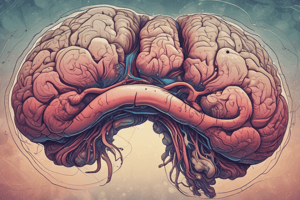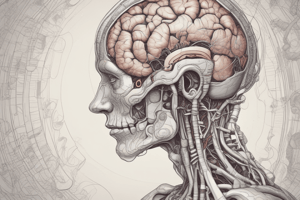Podcast
Questions and Answers
What is the primary function of the nervous system in the human body?
What is the primary function of the nervous system in the human body?
- Producing hormones and enzymes
- Maintaining bone density and structure
- Filtering waste and excess fluids
- Generating, modulating, and transmitting information (correct)
What are the two main divisions of the nervous system?
What are the two main divisions of the nervous system?
- Central Nervous System (CNS) and Peripheral Nervous System (PNS) (correct)
- Sensory and Motor Systems
- Voluntary and Involuntary Systems
- Brain and Spinal Cord Systems
What is the main function of the autonomic nervous system?
What is the main function of the autonomic nervous system?
- Maintaining body temperature
- Regulating involuntary functions (correct)
- Processing sensory information
- Controlling voluntary movements
What is the role of the spinal cord in the nervous system?
What is the role of the spinal cord in the nervous system?
What is the main function of the somatic nervous system?
What is the main function of the somatic nervous system?
How many main parts does the brain have?
How many main parts does the brain have?
What is the primary function of the spinal cord?
What is the primary function of the spinal cord?
What is the autonomic nervous system responsible for?
What is the autonomic nervous system responsible for?
What is the primary function of the somatic nervous system?
What is the primary function of the somatic nervous system?
What is the sympathetic nervous system responsible for?
What is the sympathetic nervous system responsible for?
What is the parasympathetic nervous system responsible for?
What is the parasympathetic nervous system responsible for?
What is the significance of understanding the nervous system in clinical applications?
What is the significance of understanding the nervous system in clinical applications?
Study Notes
The Nervous System: Understanding Its Structure, Function, and Divisions
The human nervous system is a complex network of cells and tissues that play a crucial role in controlling and coordinating the functions of the body. It is the primary system responsible for the generation, modulation, and transmission of information between different parts of the body, enabling essential functions such as regulation of vital body processes, sensation, and body movements.
Structure
The nervous system consists of two main divisions: the Central Nervous System (CNS) and the Peripheral Nervous System (PNS). These divisions are interconnected, with the CNS serving as the integration and command center, and the PNS acting as the conduit between the CNS and the rest of the body.
Central Nervous System (CNS)
The CNS is composed of the brain and spinal cord. The brain is divided into four main parts: cerebrum, diencephalon, cerebellum, and brainstem. The spinal cord, which extends from the brainstem, is responsible for generating commands for involuntary processes, such as reflexes.
Peripheral Nervous System (PNS)
The PNS consists of the somatic nervous system and the autonomic nervous system. The somatic nervous system, also known as the voluntary system, controls the body's voluntary movements and sensation in the muscles and skin. The autonomic nervous system, on the other hand, is responsible for regulating involuntary functions such as breathing, digestion, and heart rate.
Function
The nervous system is responsible for several essential functions, including:
- Regulation of vital body functions (heartbeat, breathing, digestion)
- Sensation and body movements
- Consciousness, cognition, behavior, and memories
Divisions
Central Nervous System (CNS)
The CNS is further divided into the brain and spinal cord. The brain is the most complex organ in the body and is responsible for regulating all bodily functions. The spinal cord, while smaller in size, plays a vital role in transmitting sensory information from the periphery to the brain and in generating motor commands for involuntary processes.
Peripheral Nervous System (PNS)
The PNS is further subdivided into the somatic nervous system (SNS) and the autonomic nervous system (ANS). The somatic nervous system controls voluntary movements and sensation in the muscles and skin, while the autonomic nervous system regulates involuntary functions such as heart rate, digestion, and breathing.
Somatic Nervous System (SNS)
The somatic nervous system is responsible for transmitting sensory information from the periphery to the brain and for controlling voluntary movements and sensation in the muscles and skin.
Autonomic Nervous System (ANS)
The autonomic nervous system is responsible for regulating involuntary functions such as heart rate, digestion, and breathing. It is further divided into the sympathetic nervous system and the parasympathetic nervous system. The sympathetic nervous system prepares the body for physical and mental activity, while the parasympathetic nervous system is responsible for bodily functions when the body is at rest.
Clinical Notes
Understanding the nervous system is essential for various clinical applications. By studying the structure and function of the nervous system, healthcare professionals can better diagnose and treat disorders affecting the nervous system, such as epilepsy, multiple sclerosis, and Parkinson's disease.
Studying That Suits You
Use AI to generate personalized quizzes and flashcards to suit your learning preferences.
Description
This quiz covers the structure and function of the human nervous system, including the central nervous system, peripheral nervous system, and their divisions. It explores the role of the nervous system in regulating vital body functions, sensation, and body movements.




